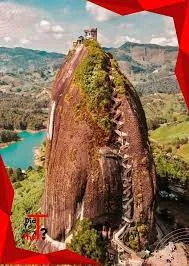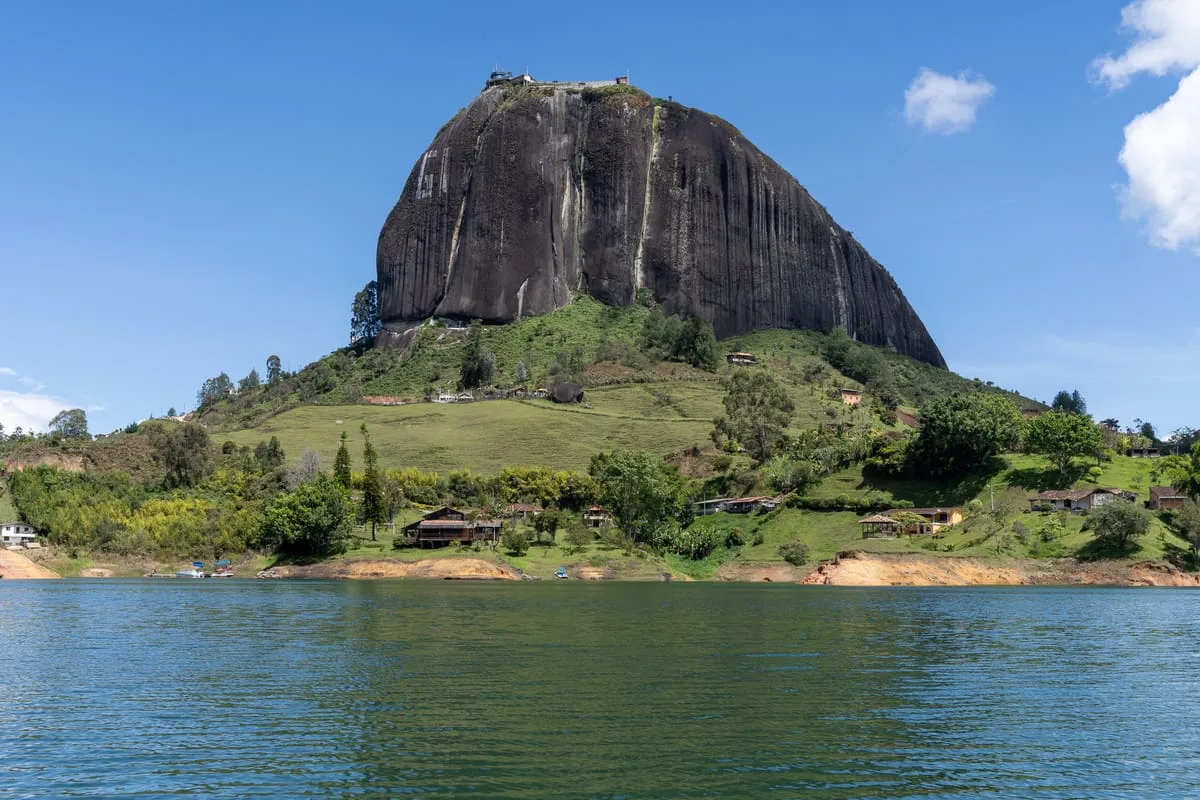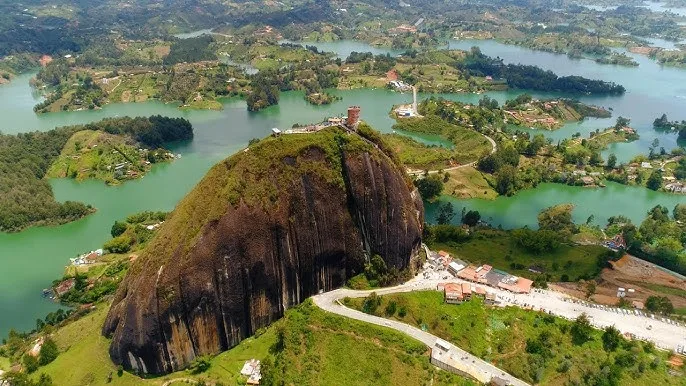El Peñón de Guatapé: Colombia’s Iconic Rock and Artificial Lake
Rising dramatically from the lush landscape of Antioquia, Colombia, El Peñón de Guatapé, also known as La Piedra del Peñol or the Rock of Guatapé, is a geological marvel and one of the country’s most iconic landmarks. This massive granite monolith, standing approximately 220 meters (722 feet) above its base and 2,150 meters (7,054 feet) above sea level, towers over the man-made Peñol-Guatapé Reservoir, a sprawling artificial lake created in the 1970s for a hydroelectric project. While some sources may exaggerate its height to around 400 meters, official measurements confirm it as 220 meters, making it a striking yet accessible natural wonder that draws thousands of tourists annually for its breathtaking views and unique history.

A Geological Giant
El Peñón de Guatapé is an inselberg, a standalone rock formation formed from granite composed of quartz, feldspar, and mica, part of the Antioquia Batholith that dates back approximately 70 million years. Shaped by tectonic uplift and millions of years of erosion, the rock resisted weathering due to its durable composition, standing proud as softer surrounding rock eroded away. Its smooth, dome-like surface, weighing an estimated 10 million tons, is a remnant of ancient magma chambers exposed during the formation of the Cordillera Occidental mountain range.
The rock’s prominence is accentuated by its location amidst the Peñol-Guatapé Reservoir, a vast artificial lake created in the 1970s by damming the Guatapé River for the Punchiná Dam. This hydroelectric project, which supplies over 35% of Colombia’s electricity, flooded the original town of El Peñol, forcing its relocation to higher ground. The reservoir’s 500-kilometer shoreline, dotted with small islets, creates a stunning backdrop of deep blue waters and green hills, often compared to Scandinavian fjords.
A Cultural and Historical Landmark
Before Spanish conquistadors arrived in the 16th century, the rock was revered by the indigenous Tahamí people, who called it “Mojarrá” or “Mujará” and worshipped it as a sacred site. Archaeological evidence suggests the surrounding area may have served as a ritual or refuse site for these communities. In the 1940s, the Colombian government declared El Peñón a National Monument, recognizing its cultural and geological significance.
The rock’s modern fame began in 1954 when Luis Eduardo Villegas López, Pedro Nel Ramírez, and Ramón Díaz scaled it over five days using wooden sticks wedged into a natural fissure. Today, a staircase of 708 steps (though some sources cite 649 or 740) is built into this fissure, allowing visitors to climb to the summit for a modest fee of about $6 USD. The ascent, while strenuous, takes 10–15 minutes and rewards climbers with panoramic views of the reservoir’s archipelago, rolling hills, and the colorful towns of Guatapé and El Peñol.

A curious piece of local history involves a territorial dispute between Guatapé and El Peñol, both of which claim the rock. In the 1980s, Guatapé residents began painting a giant “G” and “U” on the rock’s western face to assert ownership, but El Peñol locals halted the effort, leaving an incomplete “U” that resembles an “I.” This unfinished graffiti remains a quirky testament to the rivalry.
The Artificial Lake: A Modern Marvel
The Peñol-Guatapé Reservoir, often called Guatapé Lake, is a man-made wonder that transformed the region. Created as part of a hydroelectric project, it submerged the original El Peñol town, with only a cross from its church steeple visible above the water today. The lake’s creation displaced tens of thousands of residents, who were relocated to a new El Peñol, and it now powers much of Colombia and even exports electricity to neighboring countries like Venezuela. Its scenic beauty, with hundreds of islets scattered across the water, has made it a hub for watersports like kayaking, paddleboarding, and jet-skiing, as well as helicopter and paragliding tours.
From the rock
El Peñón de Guatapé: Colombia’s Iconic Rock and Artificial Lake
Rising dramatically from the lush landscape of Antioquia, Colombia, El Peñón de Guatapé, also known as La Piedra del Peñol or the Rock of Guatapé, is a geological marvel and one of the country’s most iconic landmarks. This massive granite monolith, standing approximately 220 meters (722 feet) above its base and 2,150 meters (7,054 feet) above sea level, towers over the man-made Peñol-Guatapé Reservoir, a sprawling artificial lake created in the 1970s for a hydroelectric project. While some sources may exaggerate its height to around 400 meters, official measurements confirm it as 220 meters, making it a striking yet accessible natural wonder that draws thousands of tourists annually for its breathtaking views and unique history.
A Geological Giant
El Peñón de Guatapé is an inselberg, a standalone rock formation formed from granite composed of quartz, feldspar, and mica, part of the Antioquia Batholith that dates back approximately 70 million years. Shaped by tectonic uplift and millions of years of erosion, the rock resisted weathering due to its durable composition, standing proud as softer surrounding rock eroded away. Its smooth, dome-like surface, weighing an estimated 10 million tons, is a remnant of ancient magma chambers exposed during the formation of the Cordillera Occidental mountain range.

The rock’s prominence is accentuated by its location amidst the Peñol-Guatapé Reservoir, a vast artificial lake created in the 1970s by damming the Guatapé River for the Punchiná Dam. This hydroelectric project, which supplies over 35% of Colombia’s electricity, flooded the original town of El Peñol, forcing its relocation to higher ground. The reservoir’s 500-kilometer shoreline, dotted with small islets, creates a stunning backdrop of deep blue waters and green hills, often compared to Scandinavian fjords.
A Cultural and Historical Landmark
Before Spanish conquistadors arrived in the 16th century, the rock was revered by the indigenous Tahamí people, who called it “Mojarrá” or “Mujará” and worshipped it as a sacred site. Archaeological evidence suggests the surrounding area may have served as a ritual or refuse site for these communities. In the 1940s, the Colombian government declared El Peñón a National Monument, recognizing its cultural and geological significance.
The rock’s modern fame began in 1954 when Luis Eduardo Villegas López, Pedro Nel Ramírez, and Ramón Díaz scaled it over five days using wooden sticks wedged into a natural fissure. Today, a staircase of 708 steps (though some sources cite 649 or 740) is built into this fissure, allowing visitors to climb to the summit for a modest fee of about $6 USD. The ascent, while strenuous, takes 10–15 minutes and rewards climbers with panoramic views of the reservoir’s archipelago, rolling hills, and the colorful towns of Guatapé and El Peñol.

A curious piece of local history involves a territorial dispute between Guatapé and El Peñol, both of which claim the rock. In the 1980s, Guatapé residents began painting a giant “G” and “U” on the rock’s western face to assert ownership, but El Peñol locals halted the effort, leaving an incomplete “U” that resembles an “I.” This unfinished graffiti remains a quirky testament to the rivalry.
The Artificial Lake: A Modern Marvel
The Peñol-Guatapé Reservoir, often called Guatapé Lake, is a man-made wonder that transformed the region. Created as part of a hydroelectric project, it submerged the original El Peñol town, with only a cross from its church steeple visible above the water today. The lake’s creation displaced tens of thousands of residents, who were relocated to a new El Peñol, and it now powers much of Colombia and even exports electricity to neighboring countries like Venezuela. Its scenic beauty, with hundreds of islets scattered across the water, has made it a hub for watersports like kayaking, paddleboarding, and jet-skiing, as well as helicopter and paragliding tours.
From the rock’s summit, visitors can see the reservoir’s intricate network of islands and peninsulas, a view described as “out of this world” and rivaling Norway’s fjords. The summit features a three-story viewpoint tower, a café, and souvenir shops, making it a place to linger and soak in the scenery.

A Tourist Magnet with Local Charm
Located just 79 kilometers (49 miles) from Medellín, El Peñón de Guatapé is a popular day trip or overnight destination, accessible by bus, tuk-tuk, or car. The nearby town of Guatapé, known as the “Pueblo de Zócalos” for its colorful murals and bas-relief wall art, adds cultural vibrancy with its painted houses and lively restaurants. Visitors can explore the lake by boat, visit nearby waterfalls, or relax at accommodations like Lake View Hostel or the luxurious La Pausa Hotelbistro, which offers lake views and hot tubs.


